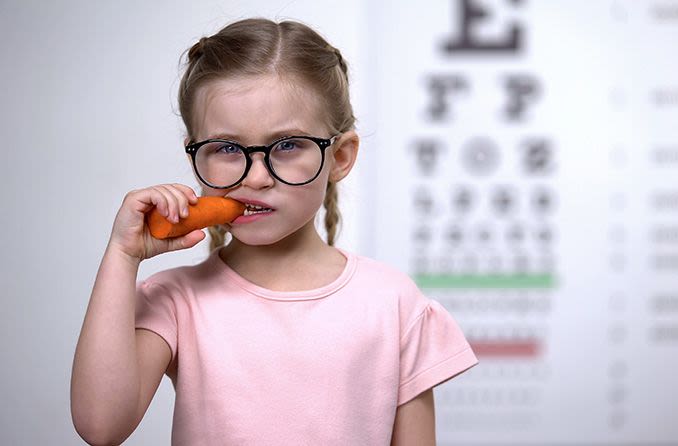Are carrots really good for your eyes?

Do carrots help your eyesight?
Carrots contain a wide array of vitamins, including vitamin A, which has been known to improve eye health. In other words, there is truth to the claim that carrots are good for your eyes.
Vitamin A is known to benefit your eye health by:
Protecting your corneas
Decreasing the risk of cataracts and age-related macular degeneration
Delaying peripheral vision loss
Creating a protective layer against bacteria and viruses
Alleviating the symptoms of dry eye syndrome
Slowing vision loss in people with retinitis pigmentosa
Impeding the progression of Stargardt’s disease
On the other hand, vitamin A deficiency can lead to:
Dry eyes
Night blindness
Vision loss
Vitamin A deficiency is rare in the United States, but it can occur when people have restricted diets or their bodies can’t absorb food properly.
It’s also possible to get too much vitamin A. This can cause:
Headaches
Joint pain
Dizziness
Are carrots the only way to get vitamin A?
When people think of eye-friendly foods, they usually think of carrots; but they’re far from the only food that benefits your eye health. In fact, carrots aren’t even the best food you can eat with eye health in mind.
Many other foods have high-to-moderate levels of vitamin A, including:
Beef liver
Sweet potatoes
Spinach (frozen, then boiled)
Ricotta cheese
Atlantic herring
Cantaloupes, mangoes and sweet red peppers
If you eat half a cup of raw carrots, you’ll get more than half of your suggested daily intake of vitamin A.
But if you aren’t a fan of carrots, you can still get vitamin A from other food sources, including the ones listed above.
For example, the average sweet potato — baked with the skin on — provides over 150% of your daily value of vitamin A.
Can carrots reverse poor eyesight?
Eating a diet that’s abundant in vitamin A and beta-carotene is great for your vision, but it can’t restore eyesight to 20/20. You’ll need help from prescription eyeglasses, contact lenses or vision surgery if you have any notable level of blurry vision.
However, if your vision is just starting to worsen, eating carrots and other sources of vitamin A could slowly improve your eyesight.
If you’re experiencing any eye or vision problems, schedule a comprehensive eye exam with an eye doctor. They are specially trained to look at (and inside) your eyes and recommend the best possible treatment.
SEE RELATED: Can I improve myopia if I eat carrots everyday?
Can carrots improve your night vision?
If you have relatively healthy vision, consuming more foods with vitamin A — including carrots — could improve your ability to see in the dark.
Vitamin A deficiency is linked to nyctalopia, the medical term for night blindness. Without vitamin A, the synthesis of rhodopsin — the part of your eyes that helps you see using low-light sources like the moon — can’t fully develop.
While certain eye and vision problems like night blindness can improve with supplementation, they can also become permanent.
How else are carrots good for you?
Your eyes are the biggest beneficiaries of a diet high in vitamin A. But early studies have shown the nutrient may also be a potential treatment tool for certain cancers.
In food form, vitamin A might help reduce the likelihood of developing some cancers, too.
While vitamin A’s current connection to cancer is somewhat mixed, it may one day offer another reason to include foods like carrots in your diet.
And don’t forget, whole foods high in vitamin A usually come packed with other vitamins and minerals, too. While you help your eyesight, you’re also contributing to the health of countless other areas of your well-being.
READ NEXT: Old wives’ tales about the eyes: Truth or myth?
What is vitamin A deficiency? American Academy of Ophthalmology. October 2020.
Vitamin A deficiency. StatsPearls. Accessed June 2021.
Vitamin A. Office of Dietary Supplements, National Institutes of Health. Accessed June 2021.
Vitamin A, cancer treatment and prevention: The new role of cellular retinol binding proteins. BioMed Research International. March 2015.
Page published on Saturday, February 29, 2020




